
List of placental mammals in Order Carnivora
Encyclopedia
Suborder FeliformiaFeliformiaThe Feliformia are a suborder within the order Carnivora and includes cats , hyenas, mongooses, civets and related taxa. The other suborder of Carnivora is Caniformia...
(cat-like carnivores)
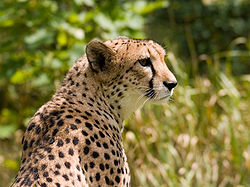
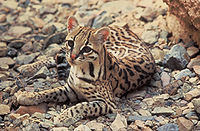

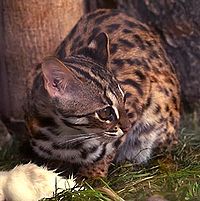
Genus CatopumaCatopumaCatopuma is a genus including two small Asian felines, the Bay Cat and the Asian Golden Cat .Both are typically reddish brown in colour, with darker markings on the head. They inhabit forested environments in South East Asia, with the Bay Cat being restricted to the island of Borneo...
- Bay CatBay CatThe Bay Cat , also known as Bornean Cat, Bornean Bay Cat, Bornean Marbled Cat, is a wild cat endemic to the island of Borneo that appears relatively rare compared to sympatric felids, based on the paucity of historical as well as recent records...
(Catopuma badia) - Asian Golden Cat (Catopuma temminckii)
Genus FelisFelisFelis is a genus of cats in the family Felidae, including the familiar domestic cat and its closest wild relatives. The wild species are distributed widely across Europe, southern and central Asia, and Africa; the domestic cat has been introduced worldwide.Members of the genus Felis are all small...
- Chinese Mountain Cat (Felis bieti)
- Domestic CatCatThe cat , also known as the domestic cat or housecat to distinguish it from other felids and felines, is a small, usually furry, domesticated, carnivorous mammal that is valued by humans for its companionship and for its ability to hunt vermin and household pests...
(Felis catus) - Jungle CatJungle CatThe jungle cat is a medium-sized cat and considered the largest remaining species of the wild cat genus Felis. The species is also called the swamp lynx but is not closely related to the lynxes....
(Felis chaus) - Pallas's Cat (Felis manul)
- Sand CatSand CatThe sand cat , also referred to as the "sand dune cat", is a small wild cat distributed over African and Asian deserts. The Sand cat lives in arid areas that are too hot and dry even for the African Wildcat: the Sahara, the Arabian Desert, and the deserts of Iran and...
(Felis margarita) - Black-footed CatBlack-footed CatThe black-footed cat is the smallest African cat, and is endemic in the south west arid zone of the southern African subregion. It is one of the lesser studied African carnivores, and has been listed as Vulnerable by IUCN since 2002....
(Felis nigripes) - WildcatWildcatWildcat is a small felid native to Europe, the western part of Asia, and Africa.-Animals:Wildcat may also refer to members of the genus Lynx:...
(Felis sylvestris)
Genus LeopardusLeopardusLeopardus is a genus consisting of small spotted cats mostly native to Middle and South America. Very few range into the southern United States. The genus is considered the oldest branch of the part of the cat family to cross into the Americas, followed by the genera Lynx and Puma...
- Pantanal (Leopardus braccatus)
- ColocoloColocoloColocolo may refer to:*Colocolo , a Mapuche tribal chief.*Colo Colo creature of the Mapuche mythology.*Colocolo , a South American cat native to Chile.*Colo-Colo, a Chilean football team....
(Leopardus colocolo) - Geoffroy's CatGeoffroy's CatGeoffroy's Cat is a wild cat in the southern and central regions of South America. It is about the size of a domestic cat. While the species is relatively common in many areas, it is considered to be "Near Threatened" by IUCN because of concern over land-use changes in the regions where it lives...
(Leopardus geoffroyi) - KodkodKodkodThe Kodkod , also called Guiña, is the smallest cat in the Americas and also has the smallest distribution, being found primarily in central and southern Chile and marginally in adjoining areas of Argentina...
(Leopardus guigna) - Andean Mountain Cat (Leopardus jacobitus)
- Pampas CatPampas CatThe Colocolo is a small spotted and striped cat native to the west Andean slope in central and northern Chile. Until recently it included the more widespread Pampas Cat and Pantanal Cat , and some maintain these as subspecies of the Colocolo...
(Leopardus pajeros) - OcelotOcelotThe ocelot , pronounced /ˈɒsəˌlɒt/, also known as the dwarf leopard or McKenney's wildcat is a wild cat distributed over South and Central America and Mexico, but has been reported as far north as Texas and in Trinidad, in the Caribbean...
(Leopardus pardalis) - Oncilla (Leopardus tigrinus)
- MargayMargayThe Margay is a spotted cat native to Middle and South America. Named for Prince Maximilian of Wied-Neuwied, it is a solitary and nocturnal animal that prefers remote sections of the rainforest. Although it was once believed to be vulnerable to extinction, the IUCN now lists it as "Near Threatened"...
(Leopardus wiedii)
Genus LynxLynxA lynx is any of the four Lynx genus species of medium-sized wildcats. The name "lynx" originated in Middle English via Latin from Greek word "λύγξ", derived from the Indo-European root "*leuk-", meaning "light, brightness", in reference to the luminescence of its reflective eyes...
- Canadian Lynx (Lynx canadensis)
- Eurasian LynxEurasian LynxThe Eurasian lynx is a medium-sized cat native to European and Siberian forests, South Asia and East Asia. It is also known as the European lynx, common lynx, the northern lynx, and the Siberian or Russian lynx...
(Lynx lynx) - Iberian LynxIberian LynxThe Iberian lynx, Lynx pardinus, is a critically endangered species native to the Iberian Peninsula in Southern Europe. It is one of the most endangered cat species in the world. According to the conservation group SOS Lynx, if this species died out, it would be one of the few feline extinctions...
(Lynx pardinus) - BobcatBobcatThe bobcat is a North American mammal of the cat family Felidae, appearing during the Irvingtonian stage of around 1.8 million years ago . With twelve recognized subspecies, it ranges from southern Canada to northern Mexico, including most of the continental United States...
(Lynx rufus)
Genus PrionailurusPrionailurusPrionailurus is a genus of four species of small, spotted wild cats found in Asia. They are typically forest-dwelling. Most are able to swim well; some species are actually semi-aquatic and feed mainly on fish and other aquatic animals....
- Leopard CatLeopard CatThe leopard cat is a small wild cat of South and East Asia. Since 2002 it has been listed as Least Concern by IUCN as it is widely distributed but threatened by habitat loss and hunting in parts of its range...
(Prionailurus bengalensis) - Iriomote CatIriomote catThe Iriomote cat , is a wild cat about the size of a domestic cat that lives exclusively on the Japanese island of Iriomote. It is considered a "living fossil" by many biologists because it has not changed much from its primitive form...
(Prionailurus iriomotensis) - Flat-headed CatFlat-headed CatThe Flat-headed Cat is a small wild cat patchily distributed in the Thai-Malay Peninsula, Borneo and Sumatra. Since 2008, it has been listed as Endangered by the IUCN due to destruction of wetlands in their habitat...
(Prionailurus planiceps) - Rusty-spotted CatRusty-spotted CatThe Rusty-spotted Cat is the cat family's smallest member and found only in India and Sri Lanka. It has been listed as Vulnerable by IUCN in 2002 as the total effective population size is below 10,000 mature individuals, with a declining trend due to habitat loss, and no subpopulation containing...
(Prionailurus rubiginosus) - Fishing CatFishing CatThe Fishing Cat is a medium-sized wild cat of South and Southeast Asia. In 2008, the IUCN classified the fishing cat as endangered since they are concentrated primarily in wetland habitats, which are increasingly being settled, degraded and converted...
(Prionailurus viverrinus)
Genus PumaPuma (genus)Puma is a genus in Felidae that contains the cougar and the jaguarundi, and may also include several poorly known Old World fossil representatives .-Species:*Puma concolor – CougarPuma pardoides Puma is a genus in Felidae that contains the cougar (also known as the puma, among other names)...
- Cougar (Puma concolor)
- JaguarundiJaguarundiThe jaguarundi is a small-sized wild cat native to Central and South America. In 2002, the IUCN classified the jaguarundi as Least Concern as it is likely that no conservation units, with the probable exception of the mega-reserves of the Amazon basin could sustain long-term viable populations. It...
(Puma yagouaroundi)
Subfamily PantherinaePantherinaePantherinae is the subfamily of the family Felidae, which includes the genera Panthera, Uncia and Neofelis.The divergence of Pantherinae from Felinae has been ranked between six and ten million years ago. DNA analysis suggests that the snow leopard Uncia uncia is basal to the entire Pantherinae and...
(large cats)
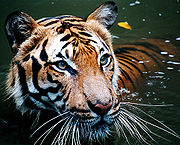
Genus NeofelisNeofelisThe genus Neofelis comprises two species, the Clouded Leopard and the Sunda Clouded Leopard , which are classified as vulnerable by IUCN. Both species are listed on CITES Appendix I.- Characteristics :...
- Clouded LeopardClouded LeopardThe clouded leopard is a felid found from the Himalayan foothills through mainland Southeast Asia into China, and has been classified as vulnerable in 2008 by IUCN...
(Neofelis nebulosa) - Bornean Clouded LeopardBornean Clouded LeopardThe Sunda clouded leopard , also known as the Sundaland clouded leopard and is a medium-sized wild cat found in Borneo and Sumatra...
(Neofelis diardi)
Genus PantheraPantheraPanthera is a genus of the family Felidae , which contains four well-known living species: the tiger, the lion, the jaguar, and the leopard. The genus comprises about half of the Pantherinae subfamily, the big cats...
- LionLionThe lion is one of the four big cats in the genus Panthera, and a member of the family Felidae. With some males exceeding 250 kg in weight, it is the second-largest living cat after the tiger...
(Panthera leo) - JaguarJaguarThe jaguar is a big cat, a feline in the Panthera genus, and is the only Panthera species found in the Americas. The jaguar is the third-largest feline after the tiger and the lion, and the largest in the Western Hemisphere. The jaguar's present range extends from Southern United States and Mexico...
(Panthera onca) - LeopardLeopardThe leopard , Panthera pardus, is a member of the Felidae family and the smallest of the four "big cats" in the genus Panthera, the other three being the tiger, lion, and jaguar. The leopard was once distributed across eastern and southern Asia and Africa, from Siberia to South Africa, but its...
(Panthera pardus) - TigerTigerThe tiger is the largest cat species, reaching a total body length of up to and weighing up to . Their most recognizable feature is a pattern of dark vertical stripes on reddish-orange fur with lighter underparts...
(Panthera tigris)
Family Viverridae (civets)
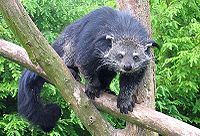
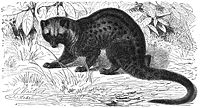
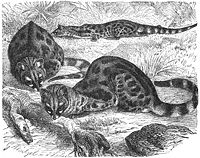


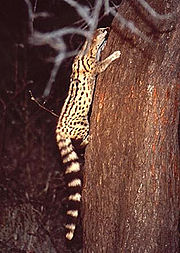
Genus Arctogalidia
- Small-toothed Palm CivetSmall-toothed Palm CivetThe Small-toothed Palm Civet , also known as the Three-striped Palm Civet, is a civet. It lives in dense forests of southeast Asia, from the Assam district of India to Indochina and the Malay Peninsula and on Sumatra, Bangka, Java, Borneo, and numerous small nearby islands of Indonesia.The...
(Arctogalidia trivirgata)
Genus Macrogalidia
- Sulawesi Palm Civet (Macrogalidia musschenbroekii)
Genus ParadoxurusParadoxurusParadoxurus is a genus of viverrids in one of the civet subfamilies, Paradoxurinae. There are at least six species, one of which is common over tropical Asia, while the others are less common and limited in locality:...
- Asian Palm Civet (Paradoxurus hermaphroditus)
- Jerdon's Palm Civet (Paradoxurus jerdoni)
- Golden Palm CivetGolden Palm CivetThe Golden Palm Civet is a civet endemic to Sri Lanka. It is a smallish civet and has a coat that is a golden brown or dark brown in color. The hair on the back of its neck grows reverse grain, from the shoulders toward the head...
(Paradoxurus zeylonensis)
Genus Prionodon
- Banded LinsangBanded LinsangThe Banded Linsang is a linsang of the Malay peninsula, Sumatra, Borneo, and western Java.-Description:The Banded Linsang is around 74 cm long including the tail. It is a pale yellow with 5 dark bands. It has broad stripes on its neck and its tail consists of several dark bands with a dark tip...
(Prionodon linsang) - Spotted LinsangSpotted LinsangThe Spotted Linsang is a linsang found in the forests of the central and eastern Himalaya. It is short, light coloured terrestrial mammal, with a slender body, a pointed head and small limbs. It stalks its prey by crawling on its belly, when it is often mistaken for a python or other heavy-built,...
(Prionodon pardicolor)
Genus Genetta
- Abyssinian GenetAbyssinian GenetThe Abyssinian Genet is a species of genet. It is native to Ethiopia, Eritrea, Somalia, Sudan, and Djibouti, and inhabits moorland, grasslands and sub-desert areas. The Abyssinian genet is rated "Least Concern" by the IUCN Red List. There are no subspecies of the Abyssinian genet....
(Genetta abyssinica) - Angolan GenetAngolan GenetThe Angolan Genet , is a mammal from the Carnivora order, related to civets and linsangs. It is one of fourteen species of genets...
(Genetta angolensis) - Bourlon's GenetBourlon's GenetThe Bourlon's Genet is a a mammal from the Carnivora order, one of fourteen species of genets. It is found in rainforest habitat in Guinea, Côte d’Ivoire, Liberia and Sierra Leone....
(Genetta bourloni) - Crested Servaline Genet (Genetta cristata)
- Common GenetCommon GenetThe Common Genet , also known as the Small-spotted Genet or European Genet, is a mammal from the order Carnivora, related to civets and linsangs. The most far-ranging of all the fourteen species of genet, it can be found throughout Africa, parts of the Middle East, and in Europe in Spain, Portugal,...
(Genetta genetta) - Johnston's GenetJohnston's GenetJohnston's Genet is a mammal from the Carnivora order, related to civets and linsangs in the family Viverridae. It is native to the African countries of Côte d'Ivoire, Ghana, Guinea and Liberia...
(Genetta johnstoni) - Rusty-spotted Genet (Genetta maculata)
- Pardine GenetPardine GenetThe Pardine Genet , is a mammal from the Carnivora order that is related to linsangs and civets. It is found in a wide range of habitats in Burkina Faso, Côte d’Ivoire, Gambia, Ghana, Guinea, Liberia, Mali, Niger, Senegal, and Sierra Leone....
(Genetta pardina) - Aquatic GenetAquatic GenetThe Aquatic Genet is a carnivoran mammal from the north-east of the Democratic Republic of the Congo. The Aquatic Genet is related to civets and linsangs. Unlike other genets who have handsomely spotted coats and ringed tails, the Aquatic Genet has a plain, rusty-coloured coat and a black tail,...
(Genetta piscivora) - King GenetKing GenetThe King genet is a species of carnivorous mammal of the family Viverridae. It is distributed within west central Africa, close to the equator, and is native to the Republic of the Congo, Equatorial Guinea, Liberia, Ghana, and Côte d'Ivoire. The King genet is often considered to be conspecific...
(Genetta poensis) - Servaline GenetServaline GenetThe Servaline Genet is a species of carnivore of the family Viverridae, related to civets and linsangs. Like all genets, it is outwardly feline, although not a close relative of the cat family.- Subspecies :...
(Genetta servalina) - Haussa GenetHaussa GenetThe Haussa Genet , also known as Thierry's Genet, is a carnivoran mammal, related to linsangs and civets. It lives in the savannah zone of Africa from Senegal to area south of Lake Chad....
(Genetta thierryi) - Cape GenetCape GenetThe Cape Genet , also known as the Blotched Genet, Large-spotted Genet or muskeljaatkat in Afrikaans, is a carnivore mammal, related to the African Linsang and to the civets. It can be found in Africa from Senegal to Somalia, and south to Namibia and South Africa, though it is absent from the...
(Genetta tigrina) - Giant Forest Genet (Genetta victoriae)
Genus Poiana
- Leighton's LinsangLeighton's LinsangLeighton's Linsang was formerly classified as Poiana richardsonii liberiensis and considered a subspecies of the African Linsang....
(Poiana leightoni) - African LinsangAfrican LinsangThe African Linsang is a species of linsang in the family Viverridae. It is endemic to Cameroon, the Central African Republic, the Democratic Republic of the Congo, Equatorial Guinea, Gabon, and the Republic of the Congo. The African linsang is a largely arboreal creature...
(Poiana richardsonii)
Genus ViverraViverraViverra is a genus of civet commonly found in Southeast Asia.-Species:* Malabar Large-spotted Civet * Large-spotted Civet * Malayan Civet * Large Indian Civet...
- Malabar Large-spotted Civet (Viverra civettina)
- Large-spotted CivetLarge-spotted CivetThe Large-spotted Civet is a species of civet. It is found in Asia. The rare Malabar large-spotted civet is usually considered a subspecies....
(Viverra megaspila) - Malayan Civet (Viverra tangalunga)
- Large Indian CivetLarge Indian CivetThe Large Indian Civet is a member of the Viverrid family native to Southeast Asia. In 2008, the IUCN classified the species as Near Threatened, mainly because of the known heavy trade as wild meat.- Characteristics :...
(Viverra zibetha)
Genus GalidictisGalidictisGalidictis is a genus of carnivoran in the family Eupleridae endemic to Madagascar.It contains the following species:* Broad-striped Malagasy Mongoose .* Grandidier's Mongoose ....
- Broad-striped Malagasy MongooseBroad-striped Malagasy MongooseThe Broad-striped Malagasy Mongoose, Galidictis fasciata, is a species of mongoose. It is a forest-dweller native to eastern Madagascar. The species contains two known subspecies: G. f. striata and G. f. fasciata...
(Galidictis fasciata) - Grandidier's Mongoose (Galidictis grandidieri)
Genus Mungotictis
- Narrow-striped MongooseNarrow-striped MongooseThe Narrow-striped Mongoose , also locally called boky-boky in Malagasy, is a member of the family Eupleridae, subfamily Galidiinae. It inhabits the dry deciduous forests of western and southwestern Madagascar...
(Mungotictis decemlineata)
Genus BdeogaleBdeogaleBdeogale is a genus of three species of mongoose native to the rainforests of central and western Africa. They are primarily terrestrial and insectivorous.- Species :*Bushy-tailed Mongoose, Bdeogale crassicauda - Kenya and Tanzania...
- Bushy-tailed MongooseBushy-tailed MongooseThe Bushy-tailed Mongoose is mammal in the Herpestidae found in central Africa, from southern Kenya to central Mozambique.They are 40–50 cm long; mass 0.9–1.6 kg and feed on small birds and eggs....
(Bdeogale crassicaudata) - Jackson's MongooseJackson's MongooseJackson's Mongoose is a species of mongoose belonging to the genus Bdeogale. Discovered in 1889 by Frederick John Jackson, Oldfield Thomas in 1894 described it as Galeriscus jacksoni...
(Bdeogale jacksoni) - Black-footed MongooseBlack-footed MongooseThe Black-footed Mongoose is a species of Mongoose found in central Africa. Unlike most similar species, the black-footed mongoose has only 4 toes on each limb rather than 5.-References:...
(Bdeogale nigripes)
Genus CrossarchusCrossarchusCrossarchus is a genus of mongoose, commonly referred to as the kusimanse, mangue, or dwarf mongoose.-Range and habitat:...
- Alexander's Kusimanse (Crossarchus alexandri)
- Angolan Kusimanse (Crossarchus ansorgei)
- Common Kusimanse (Crossarchus obscurus)
- Flat-headed Kusimanse (Crossarchus platycephalus)
Genus GalerellaGalerellaGalerella is a genus of mongooses native to Africa commonly called the slender mongooses.There are four species in this genus:* Angolan Slender Mongoose, Galerella flavescens* Somalian Slender Mongoose, Galerella ochracea...
- Angolan Slender Mongoose (Galerella flavescens)
- Somalian Slender MongooseSomalian Slender MongooseThe Somalian Slender Mongoose is a mongoose endemic to Somalia....
(Galerella ochracea) - Cape Gray Mongoose (Galerella pulverulenta)
- Slender MongooseSlender MongooseThe Slender Mongoose , also known as the Black-tipped Mongoose or the Black-tailed Mongoose, is a very common species of mongoose.-Range and habitat:...
(Galerella sanguinea)
Genus HelogaleHelogaleHelogale is a genus of two species of mongooses, namely the Common Dwarf Mongoose and Ethiopian Dwarf Mongoose. They are the smallest species of mongoose and both are endemic to Africa. The distribution of the latter species is more tropical, and overlaps completely with that of the Common Dwarf...
- Ethiopian Dwarf Mongoose (Helogale hirtula)
- Common Dwarf Mongoose (Helogale parvula)
Genus HerpestesHerpestesHerpestes is a genus of the mongoose family, Herpestidae .It contains the following species and subspecies:* Short-tailed Mongoose, Herpestes brachyurus** H. b. brachyurus...
- Short-tailed MongooseShort-tailed MongooseThe Short-tailed Mongoose is a species of mongoose that lives in the rainforests of Southeast Asia.The species is red-brown to black, with black limbs. The head is more grayish, with a black spot on the chin. This species has a total length of 60 to 65 cm and a weight of about 1.4 kg...
(Herpestes brachyurus) - Indian Gray MongooseIndian Gray MongooseThe Indian Gray Mongoose or Common Grey Mongoose is a species of mongoose mainly found in southern Asia mainly India, Pakistan, Nepal, Sri Lanka and some other parts of Asia. The gray mongoose is commonly found in open forests, scrub lands and cultivated fields, often close to human habitation...
(Herpestes edwardsi) - Indian Brown MongooseIndian Brown Mongoose| name = Indian Brown Mongoose| image = Brown Mongoose.jpg| image_caption =Adult from the southern Western Ghats| status = VU | status_system = IUCN3.1| status_ref = | regnum = Animalia| phylum = Chordata| classis = Mammaliayugioh zexal...
(Herpestes fuscus) - Egyptian MongooseEgyptian mongooseThe Egyptian Mongoose , also known as the Ichneumon, is a species of mongoose. It may be a reservoir host for Visceral leishmaniasis in Sudan.-Range and habitat:...
(Herpestes ichneumon) - Small Asian Mongoose (Herpestes javanicus)
- Long-nosed MongooseLong-nosed MongooseThe Long-nosed Mongoose is a mongoose native to Cameroon, Republic of the Congo, The Democratic Republic of the Congo, Equatorial Guinea, Gabon, Kenya, Niger, and Tanzania....
(Herpestes naso) - Collared MongooseCollared MongooseThe Collared Mongoose is a species of mongoose in the Herpestidae family. It is found in Brunei, Indonesia, and Malaysia....
(Herpestes semitorquatus) - Ruddy MongooseRuddy MongooseThe Ruddy Mongoose is a species of mongoose found in hill forests of peninsular India and Sri Lanka. This mongoose along with the Striped-necked Mongoose are the only mongoose species endemic to India and Sri Lanka....
(Herpestes smithii) - Crab-eating MongooseCrab-eating MongooseThe Crab-eating Mongoose is a species of mongoose found in northwestern India, Nepal, Myanmar, southern China, and through southeast Asia, including the countries of Vietnam, Malaysia, Taiwan, Laos and Thailand....
(Herpestes urva) - Stripe-necked Mongoose (Herpestes vitticollis)
Genus MungosMungosMungos is a mongoose genus in the family Herpestidae.It contains the following species:* Gambian Mongoose, Mungos gambianus* Banded Mongoose, Mungos mungo...
- Gambian MongooseGambian MongooseThe Gambian mongoose is widely distributed in the moist savannahs of north-western Africa, from Gambia to Nigeria.-Appearance:The Gambian mongoose is generally a brownish-grey color. They have a dark streak of fur on the sides of its light-colored neck. The short, tapered tail is not bushy. They...
(Mungos gambianus) - Banded MongooseBanded MongooseThe Banded Mongoose is a mongoose commonly found in the central and eastern parts of Africa. It lives in savannas, open forests and grasslands and feeds primarily on beetles and millipedes. Mongooses use various types of dens for shelter including termite mounds...
(Mungos mungo)
Genus HyaenaHyaenaFor the Siouxsie and the Banshees album, see Hyæna.For the group of animals commonly known as "hyaena", see Hyena.Hyaena is a genus comprising two of the living species of hyenas: the striped hyena from western Asia and northern Africa and the brown hyena from southern Africa...
- Brown HyenaBrown HyenaThe brown hyena is a species of hyena which occurs in Namibia, Botswana, western and southern Zimbabwe, southern Mozambique and South Africa. It is currently the rarest hyena.-Description:...
(Hyaena brunnea) - Striped HyenaStriped HyenaThe Striped Hyena is a species of true hyena native to North and East Africa, the Caucasus, the Middle East, Middle and Central Asia and the Indian Subcontinent...
(Hyaena hyaena)
Family AiluridaeAiluridaeAiluridae is a family in the mammal order Carnivora. The family includes the Red Panda and its extinct relatives.-Classification history:...
Family CanidaeCanidaeCanidae is the biological family of carnivorous and omnivorous mammals that includes wolves, foxes, jackals, coyotes, and domestic dogs. A member of this family is called a canid . The Canidae family is divided into two tribes: Canini and Vulpini...
(FoxFoxFox is a common name for many species of omnivorous mammals belonging to the Canidae family. Foxes are small to medium-sized canids , characterized by possessing a long narrow snout, and a bushy tail .Members of about 37 species are referred to as foxes, of which only 12 species actually belong to...
es, Wolves, CoyoteCoyoteThe coyote , also known as the American jackal or the prairie wolf, is a species of canine found throughout North and Central America, ranging from Panama in the south, north through Mexico, the United States and Canada...
s, DogDogThe domestic dog is a domesticated form of the gray wolf, a member of the Canidae family of the order Carnivora. The term is used for both feral and pet varieties. The dog may have been the first animal to be domesticated, and has been the most widely kept working, hunting, and companion animal in...
s, JackalJackalAlthough the word jackal has been historically used to refer to many small- to medium-sized species of the wolf genus of mammals, Canis, today it most properly and commonly refers to three species: the black-backed jackal and the side-striped jackal of sub-Saharan Africa, and the golden jackal of...
s, and the DholeDholeThe dhole is a species of canid native to South and Southeast Asia. It is the only extant member of the genus Cuon, which differs from Canis by the reduced number of molars and greater number of teats...
)
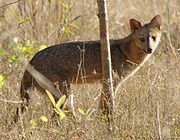
Genus VulpesVulpesVulpes is a genus of the Canidae family. Its members are referred to as 'true foxes', although there are species in other genera whose common names include the word 'fox'....
- Red FoxRed FoxThe red fox is the largest of the true foxes, as well as being the most geographically spread member of the Carnivora, being distributed across the entire northern hemisphere from the Arctic Circle to North Africa, Central America, and the steppes of Asia...
(V. vulpes) - Corsac FoxCorsac FoxThe corsac fox , also known as the steppe fox, is a medium sized Asiatic fox species found throughout the central steppes of Asia. It is sometimes referred to as the "sand fox", but this terminology is confusing because two other species, the Tibetan sand fox and Rüppell's fox are also sometimes...
(V. corsac) - Tibetan FoxTibetan FoxThe Tibetan sand fox is a species of true fox endemic to the high Tibetan Plateau in Nepal, China, Sikkim, and Bhutan, up to altitudes of about 5300 m...
(V. ferrilata) - Blanford's FoxBlanford's FoxBlanford's fox , is a small fox found in certain regions of the Middle East.-Other names:It is also known as the Afghan fox, royal fox, Corsac, dog fox, hoary fox, steppe fox, black fox, king fox, cliff fox or Baluchistan fox...
(V. cana) - Swift FoxSwift FoxThe swift fox is a small light orange-tan fox around the size of a domestic cat found in the western grasslands of North America, such as Colorado, New Mexico and Texas. It also lives in Manitoba, Saskatchewan and Alberta in Canada, where it was previously extirpated...
(V. velox) - Kit FoxKit FoxThe kit fox is a fox species of North America. Its range is primarily in the southwestern United States and northern and central Mexico. Some mammalogists classify it as conspecific with the swift fox, V. velox, but molecular systematics imply that the two species are distinct.-Range:The...
(V. macrotis) - Bengal FoxBengal FoxThe Bengal fox , also known as the Indian fox, is a fox endemic to the Indian subcontinent and is found from the Himalayan foothills and Terai of Nepal through southern India and from southern and eastern Pakistan to eastern India and southeastern Bangladesh.-Appearance:Vulpes bengalensis is a...
(V. bengalensis) - Rüppell's FoxRüppell's FoxRüppell's fox , also spelled Rueppell's fox and also called the sand fox, is a species of fox living in North Africa and the Middle East, from Morocco and the Sahel region to the Afghanistan hills. and SW Pakistan It is named after the German collector Eduard Rüppell...
(V. ruppelli) - Pale FoxPale FoxThe pale fox , also known as the African sand fox or the pallid fox is a species of fox found in the band of African Sahel from Senegal in the west to Sudan in the east...
(V. pallida) - Cape FoxCape FoxThe Cape fox , also called the cama fox or the silver-backed fox, is a small fox.It has black or silver gray fur with flanks and underside in light yellow. The tip of its tail is always black....
(V. chama) - Arctic FoxArctic foxThe arctic fox , also known as the white fox, polar fox or snow fox, is a small fox native to Arctic regions of the Northern Hemisphere and is common throughout the Arctic tundra biome. The Greek word alopex, means a fox and Vulpes is the Latin version...
(V. lagopus) - FennecFennecThe fennec fox is a small nocturnal fox found in the Sahara of North Africa. Its most distinctive feature is unusually large ears. The name "fennec" comes from the Arabic word for fox, and the species name zerda has a Greek origin that refers to its habitat...
(V. zerda)
Genus UrocyonUrocyonThe genus Urocyon is a genus that contains two living Western Hemisphere foxes in the family Canidae, the Gray Fox and the closely related Island Fox which is a dwarf cousin of the Gray Fox; as well as one fossil species, Urocyon progressus.Urocyon and the...
- Common Gray FoxGray FoxThe gray fox is a mammal of the order Carnivora ranging throughout most of the southern half of North America from southern Canada to the northern part of South America...
(U. cinereoargenteus) - Channel Islands Gray FoxIsland FoxThe island fox is a small fox that is native to six of the eight Channel Islands of California. There are six subspecies of the fox, each unique to the island it lives on, reflecting its evolutionary history...
(U. littoralis)
Genus Lycalopex
- Hoary FoxHoary FoxThe hoary fox , also called the hoary zorro, is a species of zorro or "false" fox endemic to Brazil. Unlike many other foxes, it feeds primarily on small invertebrates such as insects.-Description:...
(L. vetulus) - Pampas FoxPampas FoxThe Pampas fox , also known as graxaim, sorro, Azara's fox, or Azara's zorro, is a medium sized zorro or "false" fox native to South American pampas and its range is through central South America in Argentina, Uruguay, Paraguay and Brazil...
(L. gymnocercus) - CulpeoCulpeoThe culpeo , sometimes known as the culpeo zorro or Andean fox , is a South American species of wild dog. It is the second largest native canid on the continent after the maned wolf. In its appearance it bears many similarities to the widely recognized red fox...
(L. culpaeus) - South American Gray Fox (L. griseus)
- Sechuran Fox (L. sechurae)
- Darwin's FoxDarwin's FoxDarwin's fox or Darwin's Zorro is a small Critically endangered canine from the genus Lycalopex. It is also known as the Zorro Chilote or Zorro de Darwin in Spanish and lives on Chiloé Island and Nahuelbuta National Park in mainland Chile .Darwin's fox was first collected from San Pedro Island off...
(L. fulvipes)
Genus DusicyonDusicyonDusicyon is a genus of extinct South American canids. The type species is Dusicyon australis, the extinct Falkland Islands Wolf. In 1914, Oldfield Thomas established the genus Dusicyon, in which he included the Culpeo and other South American foxes...
- Falkland Island FoxFalkland Island FoxThe Falkland Islands Wolf , also known as the Warrah and occasionally as the Falkland Islands Dog, Falkland Islands Fox or Antarctic Wolf, was the only native land mammal of the Falkland Islands. This endemic canid became extinct in 1876 , the first known canid to have gone extinct in historical...
(D. australis)(ExtinctExtinctionIn biology and ecology, extinction is the end of an organism or of a group of organisms , normally a species. The moment of extinction is generally considered to be the death of the last individual of the species, although the capacity to breed and recover may have been lost before this point...
)
Genus NyctereutesNyctereutesNyctereutes is an east Asian genus of the family Canidae, consisting of just one living species, the Raccoon Dog. Nyctereutes appeared about 9.0 Ma, with all but one species becoming extinct before the Pleistocene.-Taxonomy:...
- Raccoon DogRaccoon DogThe raccoon dog , also known as the magnut or tanuki, is a canid indigenous to east Asia. It is the only extant species in the genus Nyctereutes...
(N. procyonoides)
Genus CanisCanisCanis is a genus containing 7 to 10 extant species, including dogs, wolves, coyotes, and jackals, and many extinct species.-Wolves, dogs and dingos:Wolves, dogs and dingos are subspecies of Canis lupus...
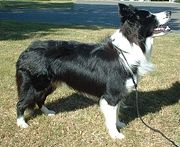
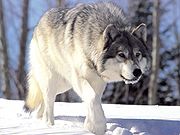
- Ethiopian WolfEthiopian WolfThe Ethiopian wolf , also known as the Abyssinian wolf, Abyssinian fox, red jackal, Simien fox, or Simien jackal is a canid native to Africa...
(C. simensis) - Side-striped JackalSide-striped JackalThe side-striped jackal is a species of jackal, native to central and southern Africa. Unlike its cousin, the smaller black-backed jackal, which dwells in open plains, the side-striped jackal primarily dwells in woodland and scrub areas....
(C. adustus) - Black-backed JackalBlack-backed JackalThe black-backed jackal , also known as the silver-backed or red jackal, is a species of jackal which inhabits two areas of the African continent separated by roughly 900 km. One region includes the southern-most tip of the continent, including South Africa, Namibia, Botswana, and Zimbabwe...
(C. mesomelas) - Golden JackalGolden JackalThe golden jackal , also known as the common jackal, Asiatic jackal, thos or gold-wolf is a Canid of the genus Canis indigenous to north and northeastern Africa, southeastern and central Europe , Asia Minor, the Middle East and southeast Asia...
(C. aureus) - CoyoteCoyoteThe coyote , also known as the American jackal or the prairie wolf, is a species of canine found throughout North and Central America, ranging from Panama in the south, north through Mexico, the United States and Canada...
(C. latrans) - Gray WolfGray WolfThe gray wolf , also known as the wolf, is the largest extant wild member of the Canidae family...
(C. lupus) - Domestic DogDogThe domestic dog is a domesticated form of the gray wolf, a member of the Canidae family of the order Carnivora. The term is used for both feral and pet varieties. The dog may have been the first animal to be domesticated, and has been the most widely kept working, hunting, and companion animal in...
(C. lupus familiaris) - DingoDingoThe Australian Dingo or Warrigal is a free-roaming wild dog unique to the continent of Australia, mainly found in the outback. Its original ancestors are thought to have arrived with humans from southeast Asia thousands of years ago, when dogs were still relatively undomesticated and closer to...
(C. lupus dingoCanis lupus dingoThe taxon Canis lupus dingo is named for its most famous and original member, the Australian Dingo, but it also includes non-Australian animals such as the New Guinea Singing Dog, the Thai Dog, and other animals which are considered taxonomically identical to the Australian Dingo. so any...
) - Red WolfRed WolfThe red wolf is a North American canid which once roamed throughout the Southeastern United States and is a glacial period survivor of the Late Pleistocene epoch...
(C. rufus)
Family Ursidae (BearBearBears are mammals of the family Ursidae. Bears are classified as caniforms, or doglike carnivorans, with the pinnipeds being their closest living relatives. Although there are only eight living species of bear, they are widespread, appearing in a wide variety of habitats throughout the Northern...
s)


Genus Ursus
- Asiatic black bearAsiatic Black BearThe Asian black bear , also known as the moon bear or white-chested bear is a medium-sized species of bear, largely adapted for arboreal life, which occurs through much of southern Asia, Korea, northeastern China, the Russian far east and Honshū and Shikoku islands of Japan...
(U. thibetanus) - American Black BearAmerican black bearThe American black bear is a medium-sized bear native to North America. It is the continent's smallest and most common bear species. Black bears are omnivores, with their diets varying greatly depending on season and location. They typically live in largely forested areas, but do leave forests in...
(U. americanus) - Brown BearBrown BearThe brown bear is a large bear distributed across much of northern Eurasia and North America. It can weigh from and its largest subspecies, the Kodiak Bear, rivals the polar bear as the largest member of the bear family and as the largest land-based predator.There are several recognized...
(U. arctos) - Polar BearPolar BearThe polar bear is a bear native largely within the Arctic Circle encompassing the Arctic Ocean, its surrounding seas and surrounding land masses. It is the world's largest land carnivore and also the largest bear, together with the omnivorous Kodiak Bear, which is approximately the same size...
(U. maritimus)
Family ProcyonidaeProcyonidaeProcyonidae is a New World family of the order Carnivora. It includes the raccoons, coatis, kinkajous, olingos, ringtails and cacomistles. Procyonids inhabit a wide range of environments, and are generally omnivorous.-Characteristics:...
(RingtailRingtailThe ringtail is a mammal of the raccoon family , native to arid regions of North America. It is also known as the ringtail cat, ring-tailed cat or miner's cat, and is also sometimes mistakenly called a "civet cat"...
, CacomistleCacomistleThe cacomistle is a nocturnal, arboreal and omnivorous member of the carnivoran family Procyonidae. Its preferred habitats are wet, tropical, evergreen woodlands and mountain forests, though seasonally it will range into drier deciduous forests.Nowhere in its range is B. sumichrasti common...
, RaccoonRaccoonProcyon is a genus of nocturnal mammals, comprising three species commonly known as raccoons, in the family Procyonidae. The most familiar species, the common raccoon , is often known simply as "the" raccoon, as the two other raccoon species in the genus are native only to the tropics and are...
s, CoatiCoatiCoatis, genera Nasua and Nasuella, also known as the Brazilian aardvark, Mexican tejón, hog-nosed coon, pizotes, crackoons and snookum bears, are members of the raccoon family . They are diurnal mammals native to South America, Central America, and south-western North America...
s, KinkajouKinkajouThe kinkajou , also known as the honey bear , is a rainforest mammal of the family Procyonidae related to olingos, coatis, raccoons, and the ringtail and cacomistle. It is the only member of the genus Potos. Kinkajous may be mistaken for ferrets or monkeys, but are not closely related...
, and OlingoOlingoOlingos are small procyonids that comprise the genus Bassaricyon, native to the rainforests of Central and South America from Nicaragua to Peru. They are arboreal and nocturnal, and live at elevations from sea level to 2,000 m...
s)
.jpg)

Genus BassariscusBassariscusBassariscus is a genus in the family Procyonidae. There are two species in the genus: the ringtail or ring-tailed cat and the cacomistle . Genetic studies have suggested that the closest relatives of Bassariscus are raccoons.The genus was first described by Elliott Coues in 1887...
- Ring-tailed CatRing-tailed CatThe ringtail is a mammal of the raccoon family , native to arid regions of North America. It is also known as the ringtail cat, ring-tailed cat or miner's cat, and is also sometimes mistakenly called a "civet cat"...
(B. astutus) - CacomistleCacomistleThe cacomistle is a nocturnal, arboreal and omnivorous member of the carnivoran family Procyonidae. Its preferred habitats are wet, tropical, evergreen woodlands and mountain forests, though seasonally it will range into drier deciduous forests.Nowhere in its range is B. sumichrasti common...
(B. sumichrasti)
Genus ProcyonProcyonProcyon is the brightest star in the constellation Canis Minor. To the naked eye, it appears to be a single star, the seventh brightest in the night sky with a visual apparent magnitude of 0.34...
- Common RaccoonRaccoonProcyon is a genus of nocturnal mammals, comprising three species commonly known as raccoons, in the family Procyonidae. The most familiar species, the common raccoon , is often known simply as "the" raccoon, as the two other raccoon species in the genus are native only to the tropics and are...
(P. lotor) - Tres Marias RaccoonTres Marias RaccoonThe Tres Marias raccoon is a subspecies of the common raccoon endemic on the two main islands of the Islas Marías, an archipelago off the western coast of the Mexican state of Nayarit.- Classification :...
(P. insularis) - Bahaman RaccoonBahaman Raccoon- Bahamian Raccoon :The Bahamian raccoon , also called Bahama raccoon or Bahamas raccoon, is a subspecies of the common raccoon endemic on the New Providence Island in the Bahamas.- Classification :...
(P.maynardi) - Cozumel RaccoonCozumel RaccoonThe Cozumel raccoon , also called the pygmy raccoon, is a critically endangered species of raccoon endemic on Cozumel Island off the coast of the Yucatan Peninsula, Mexico.The pygmy raccoon goes by a variety of common names...
(P. pygmaeus) - Guadeloupe RaccoonGuadeloupe RaccoonThe Guadeloupe raccoon is a subspecies of the common raccoon endemic on the two main islands Basse-Terre Island and Grande-Terre of Guadeloupe in the Lesser Antilles.- Classification :...
(P. minor) - Barbados RaccoonBarbados RaccoonThe Barbados raccoon is an extinct subspecies of the common raccoon , that was endemic on Barbados in the Lesser Antilles until 1964.- Classification :...
(P. gloveralleni) - Crab-eating RaccoonCrab-eating raccoonThe Crab-eating Raccoon is a species of raccoon native to marshy and jungle areas of Central and South America . It is found from Costa Rica south through most areas of South America east of the Andes down to northern Argentina and Uruguay...
(P. cancrivorus)
Genus NasuaNasuaNasua is a genus within the Raccoon family, Procyonidae. The three species within the genus Nasua are generally referred to as coatis. Two additional species of coatis, commonly known as mountain coatis, are placed in the genus Nasuella...
- White-nosed Coati (N. narica)
- Cozumel Island CoatiCozumel Island CoatiThe Cozumel Island Coati is a coati from the Mexican island of Cozumel. It is in the family Procyonidae, which also includes raccoons, olingos, and Kinkajous....
(N. nelsoni) - South American CoatiSouth American CoatiThe South American Coati, or Ring-tailed Coati , is a species of coati from South America. In Brazilian Portuguese it is known as quati. It is native to Argentina, Bolivia, Brazil, Colombia, Ecuador, Guyana, Paraguay, Peru, Surinam, Uruguay and Venezuela. It is the southern replacement of its very...
(N. nasusa)
Genus Bassaricyon
- OlingoOlingoOlingos are small procyonids that comprise the genus Bassaricyon, native to the rainforests of Central and South America from Nicaragua to Peru. They are arboreal and nocturnal, and live at elevations from sea level to 2,000 m...
(B. gabbii) - Chiriqui OlingoChiriqui OlingoThe Chiriqui Olingo is a species of olingo found in Central America. It is known only from Chiriqui Province in western Panama.- External links :*...
(B. pauli) - Harris's OlingoHarris's OlingoHarris's Olingo is a species of olingo from Central America, where it is found in the Cordillera Central of Costa Rica. Because of ongoing taxonomic uncertainty this species is considered to be data deficient....
(B. lasius) - Beddard's OlingoBeddard's OlingoBeddard's Olingo, Bassaricyon beddardi, is an olingo species from South America. It is found in Brazil, Guyana and Venezuela. Olingos appear similar to the kinkajou ; however, they lack a prehensile tail, and are not closely related. Their tails are bushier and have faint black bands, like most...
(B.beddardi) - Allen's OlingoAllen's OlingoAllen's Olingo is a species of olingo from South America, where it is known from Bolivia, Ecuador and Peru....
(B. alleni)
Family MustelidaeMustelidaeMustelidae , commonly referred to as the weasel family, are a family of carnivorous mammals. Mustelids are diverse and the largest family in the order Carnivora, at least partly because in the past it has been a catch-all category for many early or poorly differentiated taxa...
(WeaselWeaselWeasels are mammals forming the genus Mustela of the Mustelidae family. They are small, active predators, long and slender with short legs....
s, MinkMinkThere are two living species referred to as "mink": the European Mink and the American Mink. The extinct Sea Mink is related to the American Mink, but was much larger. All three species are dark-colored, semi-aquatic, carnivorous mammals of the family Mustelidae, which also includes the weasels and...
, Polecats, FerretFerretThe ferret is a domesticated mammal of the type Mustela putorius furo. Ferrets are sexually dimorphic predators with males being substantially larger than females. They typically have brown, black, white, or mixed fur...
s, MartenMartenThe martens constitute the genus Martes within the subfamily Mustelinae, in family Mustelidae.-Description:Martens are slender, agile animals, adapted to living in taigas, and are found in coniferous and northern deciduous forests across the northern hemisphere. They have bushy tails, and large...
s, WolverineWolverineThe wolverine, pronounced , Gulo gulo , also referred to as glutton, carcajou, skunk bear, or quickhatch, is the largest land-dwelling species of the family Mustelidae . It is a stocky and muscular carnivore, more closely resembling a small bear than other mustelids...
, Badgers, and OtterOtterThe Otters are twelve species of semi-aquatic mammals which feed on fish and shellfish, and also other invertebrates, amphibians, birds and small mammals....
s)
Genus Mustela
- Colombian WeaselColombian WeaselColombian weasel , also known as Don Felipe's weasel, is a very rare species of weasel only known with certainty from the departments of Huila and Cauca in Colombia and nearby northern Ecuador...
(M. felipei) - Tropical WeaselTropical WeaselThe Amazon weasel , also known as the tropical weasel, is a species of weasel that lives in the Amazon Rainforest in South America. It is rated "Least Concern" by the IUCN Red List. Despite its scientific name, it is not found in Africa. It is a shiny brown weasel with a white or cream belly with a...
(M. africana) - ErmineErmineErmine has several uses:* A common name for the stoat * The white fur and black tail end of this animal, which is historically worn by and associated with royalty and high officials...
(M. erminea) - Least WeaselLeast WeaselThe least weasel is the smallest member of the Mustelidae , native to Eurasia, North America and North Africa, though it has been introduced elsewhere. It is classed as Least Concern by the IUCN, due to its wide distribution and presumably large population...
(M. nivalis) - Long-tailed WeaselLong-tailed WeaselThe long-tailed weasel , also known as the bridled weasel or big stoat is a species of mustelid distributed from southern Canada throughout all the United States and Mexico, southward through all of Central America and into northern South America.-Evolution:The long-tailed weasel is the product of...
(M. frenata) - Mountain WeaselMountain WeaselThe mountain weasel , also known as the pale weasel, Altai weasel or solongoi, is a species of weasel that prefer to live in environments that are usually high in altitude as well as rocky tundra and grassy woodlands covered in green vegetation.They rest in rock crevices, tree trunks, and...
(M. altaica) - Yellow-bellied WeaselYellow-bellied WeaselThe yellow-bellied weasel is a species of weasel. It lives in the pine forests of Bhutan, China, India, Laos, Myanmar, Nepal, Thailand, and Vietnam. The yellow-bellied weasel is rated "Least Concern" by the IUCN Red List. The yellow-bellied weasel is named for its yellow-colored underbelly. The...
(M. kathiah) - European MinkEuropean minkThe European mink , also known as the Russian mink, is a semi-aquatic species of Mustelid native to Europe. It is listed by the IUCN as Endangered due to an ongoing reduction in numbers, having been calculated as being more than 50% over the past three generations...
(M. lutreola) - Siberian WeaselSiberian WeaselThe Siberian weasel , also known as the Kolonok, is a medium-sized species of weasel native to Asia. It is classed as Least Concern for extinction by the IUCN, due to its wide distribution and presumably large numbers....
(M. sibirica) - Indonesian Mountain WeaselIndonesian Mountain WeaselThe Indonesian mountain weasel is a species of weasel that lives on the islands of Java and Sumatra in Indonesia at elevations over 1,000 metres . They live in mountainous, tropical, and rainforest areas. Indonesian mountain weasels have a body length of 11-12 inches and a tail length of 5-6 inches...
(M. lutreolina) - Malaysian Weasel (M. nudipes)
- Black-striped WeaselBlack-striped WeaselThe Back-striped Weasel is one of the most enigmatic mammals in the north-east Oriental region, even though it occurs from Nepal east through north east India, Myanmar and southern China to Vietnam, and south to central Laos at altitudes from 1000m to 2500m.It is distinguished from all other...
(M. strigidorsa) - European PolecatEuropean polecatThe European polecat , also known as the black or forest polecat , is a species of Mustelid native to western Eurasia and North Africa, which is classed by the IUCN as Least Concern due to its wide range and large numbers. It is of a generally dark brown colour, with a pale underbelly and a dark...
(M. putorius) - Steppe PolecatSteppe polecatThe steppe polecat , also known as the white or masked polecat, is a species of Mustelid native to Central and Eastern Europe and Central Asia...
(M. eversmannii) - Black-footed FerretBlack-footed FerretThe Black-footed Ferret , also known as the American polecat or Prairie Dog Hunter, is a species of Mustelid native to central North America. It is listed as endangered by the IUCN, because of its very small and restricted populations...
(M. nigripes)
Genus NeovisonNeovisonA genus of Mustelids, including the extinct sea mink and the extant American mink....
- American MinkAmerican MinkThe American mink is a semi-aquatic species of Mustelid native to North America, though human intervention has expanded its range to many parts of Europe and South America. Because of this, it is classed as Least Concern by the IUCN. Since the extinction of the sea mink, the American mink is the...
(N. vison) - Sea MinkSea MinkThe Sea Mink, Neovison macrodon, is an extinct North American member of the family Mustelidae. It is the only mustelid, and one of only two terrestrial mammal species in the order Carnivora, to become extinct in historic times . The body of the sea mink was significantly longer than that of the...
(N. macrodon)
Genus Martes
- Beech MartenBeech MartenThe beech marten , also known as the stone marten or white breasted marten, is a species of marten native to much of Europe and Central Asia, though it has established a feral population in North America. It is listed as Least Concern by the IUCN on account of its wide distribution, its large...
(M. foina) - European Pine Marten (M. martes)
- SableSableThe sable is a species of marten which inhabits forest environments, primarily in Russia from the Ural Mountains throughout Siberia, in northern Mongolia and China and on Hokkaidō in Japan. Its range in the wild originally extended through European Russia to Poland and Scandinavia...
(M. zibellina) - Japanese Marten (M. melampusMartes melampusThe Japanese marten is a mammal in the marten genus most closely related to the sable. It is half a meter in length on average, not counting a 20-centimeter-long tail, and between 1000 and 1500 grams in weight. Males are generally larger than females...
) - American MartenAmerican MartenThe American marten is a North American member of the family Mustelidae, sometimes referred to as the pine marten. The name "pine marten" is derived from the common but distinct Eurasian species of Martes...
(M. americana) - FisherFisher (animal)The fisher is a medium-size mammal native to North America. It is a member of the mustelid family, commonly referred to as the weasel family. The fisher is closely related to but larger than the American Marten...
(M. pennanti) - Yellow-throated Marten (Martes flavigulaMartes flavigulaThe yellow-throated marten , also known as the kharza, is an Asian species of marten which is listed by the IUCN as Least Concern due to its wide distribution, evidently relatively stable population, occurrence in a number of protected areas, and lack of major threats...
) - Nilgiri Marten (M. gwatkinsiiMartes gwatkinsiiThe Nilgiri marten is the only species of marten found in southern India. It occurs in the hills of the Nilgiris and parts of the Western Ghats.-Description:...
)
Genus IctonyxIctonyxIctonyx is a genus in the Mustelidae family . It contains two species:* Saharan Striped Polecat * Striped Polecat...
- Striped PolecatStriped PolecatThe Striped Polecat is a member of the Mustelidae family which somewhat resembles a skunk. It is found in savannahs and open country in sub-saharan Africa excluding the Congo basin and west Africa.Like other polecats, this carnivore is nocturnal...
(I. striatus) - Saharan Striped PolecatSaharan Striped PolecatThe Saharan striped polecat or Saharan striped weasel is a species of mammal in the Mustelidae family. It is found in Algeria, Chad, Egypt, Libya, Mali, Mauritania, Morocco, Niger, Nigeria, Sudan, Tunisia....
(I. libyca)
Genus Poecilogale
- African Striped WeaselAfrican striped weaselThe African striped weasel , the lone member of genus Poecilogale, is a small black and white weasel native to sub-Saharan Africa. It looks very much like a striped polecat, but it is much thinner and has shorter hair. It is a sleek, black color with a white tail and four white stripes running...
(P. albinucha)
Genus MydausMydausMydaus is a genus of Old World carnivore comprising two species of stink badger. There are two species - the Palawan stink badger , and the Sunda stink badger or Teledu...
- Sunda Stink Badger (M. javanensis)
- Palawan Stink BadgerPalawan Stink BadgerThe Palawan stink badger is a small skunk that lives on the Philippine Islands of Palawan and Busuanga. They live primarily in the grasslands and in cultivated areas on these islands.- External links :*...
(M. marchei)
Genus MelogaleMelogaleFerret-badgers are the five species of mustelids of the genus Melogale.* Bornean Ferret-badger * Chinese Ferret-badger * Javan Ferret-badger...
- Chinese Ferret BadgerChinese Ferret BadgerThe Chinese ferret-badger , also known as the small-toothed ferret-badger, is a member of the Mustelidae family. Distinctive mask-like face markings distinguish the Chinese ferret-badger from most other oriental mustelids, although the remaining members of the genus Melogale have comparable facial...
(M. moschata) - Javan Ferret Badger (M. orientalis)
- Burmese Ferret Badger (M. personata)
- Everett's Ferret BadgerEverett's Ferret BadgerThe Bornean ferret-badger , also known as the Everett's ferret-badger or Kinabalu ferret-badger, is a member of the Mustelidae family...
(M. everetti)
Genus LutraLutraLutra is a genus of otters.*Lutra nippon - Japanese otter*Lutra sumatrana - Hairy-nosed otter*Lutra lutra - European otter-Habitat:Lutra are semi-aquatic mammals and therefore need to be well-adapted to both water and land...
- European OtterEuropean OtterThe European Otter , also known as the Eurasian otter, Eurasian river otter, common otter and Old World otter, is a European and Asian member of the Lutrinae or otter subfamily, and is typical of freshwater otters....
(L. lutra) - Hairy-nosed OtterHairy-nosed OtterThe Hairy-nosed Otter is one of the rarest otter species on earth. Until 1998, it was thought to have been extinct. However, since then small populations have been discovered.-Measurements:Weight: Head-body length: Tail length:...
(L. sumatrana)
Genus Hydrictis
- Speckle-throated OtterSpeckle-throated OtterThe spotted-necked otter , or speckle-throated otter, is an otter native to sub-Saharan Africa. It is a smallish otter 95-105 cm long, including the tail, and weighing 3 to 6.5 kg . Like other otters it is sleek and has webbed paws for swimming...
(H. maculicollis)
Genus LutrogaleLutrogaleLutrogale is a genus of otter, with only one extant species - the smooth-coated otter.*† Lutrogale cretensis - Cretan Otter*† Lutrogale palaeoleptonyx*Lutrogale perspicillata - Smooth-coated Otter...
- Smooth-coated OtterSmooth-coated OtterThe Smooth-coated Otter is a species of otter, the only extant representative of the genus Lutrogale. The species is found from southern Pakistan and parts of the India east to Southeast Asia, and there is a disjunct population in Iraq...
(L. perspicillata)
Genus LontraLontraLontra is a genus of otters from the American continent.The genus comprises four species:*North American River Otter *Southern River Otter *Neotropical Otter...
- Northern River OtterNorthern River OtterThe North American river otter , also known as the northern river otter or the common otter, is a semiaquatic mammal endemic to the North American continent, found in and along its waterways and coasts. An adult river otter can weigh between 5 and 14 kg...
(L. canadensis) - Southern River OtterSouthern River OtterThe Southern river otter is a species of otter that lives in Chile and Argentina. Although called a "river otter", it inhabits both marine and freshwater environments....
(L. provocax) - Long-tailed Otter (L. longicaudis)
- Marine OtterMarine OtterThe marine otter, Lontra felina, is a rare and poorly-known South American mammal of the weasel family . The scientific name means "otter cat", and in Spanish the marine otter is also often referred to as : "marine cat"...
(L. felina)
Genus AonyxAonyxAonyx is a genus of otters, containing two species, the African Clawless Otter and the Oriental Small-clawed Otter. The word 'Aonyx' means 'clawless', derived from the prefix 'a-' and .-Species and subspecies:...
- African Clawless OtterAfrican Clawless OtterThe African clawless otter , also known as the cape clawless otter or groot otter, is the second largest freshwater species of otter. African clawless otters are found near permanent bodies of water in savannah and lowland forest areas...
(A. capensis) - Congo Clawless Otter (A. congicus)
Genus Amblonyx
- Oriental Small-clawed OtterOriental Small-clawed OtterThe oriental small-clawed otter , also known as Asian small-clawed otter, is the smallest otter species in the world, weighing less than 5 kg. It lives in mangrove swamps and freshwater wetlands of Bangladesh, Burma, India, southern China, Taiwan, Laos, Malaysia, Indonesia, the Philippines,...
(A. cinereus)
Genus ArctocephalusArctocephalusThe genus Arctocephalus consists of eight of the nine species of fur seal. For details see the fur seal article, or the individual species articles.-Taxonomy:* SUBORDER PINNIPEDIA* Family Otariidae...
- Guadalupe Fur SealGuadalupe Fur SealThe Guadalupe fur seal is one of six members of the fur seal genus Arctocephalus. Sealers reduced the population to just a few dozen by the late 19th century, but the species had recovered to 10,000 in number by the late 1990s...
(A. townsendi) - Juan Fernández Fur SealJuan Fernandez Fur SealThe Juan Fernández Fur Seal is a fur seal that breeds on the Juan Fernández Islands off the coast of Chile. It is the second smallest of the otariid seal . Discovered by navigator Juan Fernández in the sixteenth century, the seals became a target for sealers in the Maritime Fur Trade era...
(A. philippii) - Galápagos Fur SealGalapagos Fur SealThe Galápagos fur seal breeds on the Galápagos Islands in the eastern Pacific, west of mainland Ecuador.- Description :...
(A. galapagoensis) - South American Fur SealSouth American Fur SealThe South American Fur Seal is a species of fur seal that breeds on the coasts of Chile and Argentina. The total population is around 250,000....
(A. australis) - Amsterdam Fur Seal (A. tropicalis)
- Antarctic Fur SealAntarctic Fur SealThe Antarctic fur seal is one of eight seals in the genus Arctocephalus, and one of nine fur seals in the subfamily Arctocephalinae. As its name suggests, the Antarctic fur seal is distributed in Antarctic waters. Around 95% of the world population breeds at the Island of South Georgia...
(A. gazella) - Antipodean Fur Seal (A. forsteri)
- Brown Fur Seal (A. pusillus)
Genus Eumetopias
- Northern Sea LionSteller's Sea LionThe Steller sea lion also known as the northern sea lion, is a threatened species of sea lion in the northern Pacific. It is the sole member of the genus Eumetopias and the largest of the eared seals . Among pinnipeds, it is inferior in size only to the walrus and the two elephant seals...
(E. jubatus)
Genus ZalophusZalophusZalophus is a genus of the family Otariidae of order Carnivora. It includes three species of which one became recently extinct:*Z. californianus: California Sea Lion*Z. japonicus: Japanese Sea Lion †...
- California Sea LionCalifornia Sea LionThe California sea lion is a coastal sea lion of western North America. Their numbers are abundant , and the population continues to expand about 5% annually. They are quite intelligent and can adapt to man-made environments...
(Z. californianus) - Japanese Sea LionJapanese Sea LionThe Japanese Sea Lion is thought to have become extinct in the 1970s. Prior to 2003 it was considered to be a subspecies of California Sea Lion as Zalophus californianus japonicus. However, it was subsequently reclassified as a separate species. Some taxonomists still consider it as a subspecies...
(Z. japonicus) - Galápagos Sea LionGalápagos Sea LionThe Galápagos sea lion , a species of sea lion, exclusively breeds on the Galápagos Islands and – in smaller numbers – on Isla de la Plata . Being fairly social, and one of the most numerous species in the Galápagos archipelago, they are often spotted sun-bathing on sandy shores or rock groups or...
(Z. wollebaeki)
Genus CystophoraHooded SealThe hooded seal is an arctic pinniped found only in the central and western North Atlantic ranging from Svalbard in the east to the Gulf of St...
- Hooded SealHooded SealThe hooded seal is an arctic pinniped found only in the central and western North Atlantic ranging from Svalbard in the east to the Gulf of St...
(C. cristata)
Genus Halichoerus
- Atlantic Gray SealGrey SealThe grey seal is found on both shores of the North Atlantic Ocean. It is a large seal of the family Phocidae or "true seals". It is the only species classified in the genus Halichoerus...
(H. grypu)
Genus Leptonychotes
- Weddell SealWeddell SealThe Weddell seal , is a relatively large and abundant true seal with a circumpolar distribution surrounding Antarctica. Weddell seals have the most southerly distribution of any mammal, with a habitat that extends as far south as McMurdo Sound...
(L. weddellii)
Genus Mirounga
- Northern Elephant SealNorthern Elephant SealThe northern elephant seal is one of two species of elephant seal . It is a member of the family Phocidae . Elephant seals derive their name from their great size and from the male's large proboscis, which is used in making extraordinarily loud roaring noises, especially during the mating...
(M. angustirostris) - Southern Elephant SealSouthern Elephant SealThe Southern Elephant Seal is one of the two extant species of elephant seal. It is both the most massive pinniped and member of the order Carnivora living today...
(M. leonina)
Genus MonachusMonachusMonachus is a genus containing the monk seals, a group of three Pinniped species. They are the only earless seals which are found in tropical climates...
- Mediterranean Monk SealMediterranean Monk SealThe Mediterranean monk seal is a pinniped belonging to the Phocidae family. At some 450-510 remaining individuals, it is believed to be the world's second-rarest pinniped , and one of the most endangered mammals in the world.It is present in parts of the Mediterranean Sea and the eastern Atlantic...
(M. monachus) - Hawaiian Monk SealHawaiian Monk SealThe Hawaiian monk seal, Monachus schauinslandi, is an endangered species of earless seal in the Phocidae family that is endemic to the Hawaiian Islands....
(M. schauinslandi) - Caribbean Monk SealCaribbean Monk SealThe Caribbean monk seal or West Indian monk seal is an extinct species of seal. It is the only seal ever known to be native to the Caribbean Sea and the Gulf of Mexico. The last verified recorded sighting occurred in 1952 at Serranilla Bank...
(M. tropicalis)
Genus PhocaPhocaPhoca is a genus of the earless seals, within the Family Phocidae. It now contains just two species, the Common Seal and the Spotted Seal...
- Spotted SealSpotted SealThe spotted seal , also known as the larga or largha seal, is a member of the family Phocidae, and is considered a "true seal". It inhabits ice floes and waters of the north Pacific Ocean and adjacent seas...
(P. largha) - Harbor SealHarbor SealThe harbor seal , also known as the common seal, is a true seal found along temperate and Arctic marine coastlines of the Northern Hemisphere...
(P. vitulina)
Genus PusaPusaPusa is a genus of the earless seals, within the Family Phocidae. The three species of this genus were split from the genus Phoca, and some sources still give Phoca as an acceptable synonym for Pusa....
- Caspian SealCaspian SealCaspian seals , one of the smallest members of the earless seal family, are unique in that they are found exclusively in the brackish Caspian Sea. They can be found not only along the shorelines, but also on the many rocky islands and floating blocks of ice that dot the Caspian Sea...
(P. caspica) - Ringed SealRinged SealThe ringed seal , also known as the jar seal and as netsik or nattiq by the Inuit, is an earless seal inhabiting the Arctic and sub-Arctic regions...
(P. hispida) - Baikal Seal (P. sibirica)
Genus Spilogale
- Pygmy Spotted SkunkPygmy Spotted SkunkThe Pygmy Spotted Skunk is a species of mammal in the Mephitidae family. It is endemic to Mexico....
(S. pygmaea) - Eastern Spotted SkunkEastern Spotted SkunkThe Eastern Spotted Skunk is a small, relatively slender skunk found throughout the eastern United States and in small areas of Canada and Mexico....
(S. putorius)
Genus MephitisMephitis (genus)The genus Mephitis is one of several genera of skunks, which has two species and a North American distribution.*Striped Skunk *Hooded Skunk...
- Striped SkunkStriped SkunkThe striped skunk, Mephitis mephitis, is an omnivorous mammal of the skunk family Mephitidae. Found over most of the North American continent north of Mexico, it is one of the best-known mammals in Canada and the United States.-Description:...
(M. mephitis) - Hooded SkunkHooded SkunkThe hooded skunk is a species of mammal in the family Mephitidae. It can be distinguished from the similar striped skunk by its longer tail and longer, softer coat of fur. A ruff of white fur around its neck gives the animal its common name. It is generally more white dorsally, and black...
(M. macroura)
Genus Conepatus
- Western Hog-nosed SkunkWestern Hog-nosed SkunkRecent work has concluded that the western hog-nosed skunk or common hog-nosed skunk is the same species as the American hog-nosed skunk, and that Conepatus leuconotus is the correct name of the merged populations...
(C. mesoleucus) - Eastern Hog-nosed Skunk (C. leuconotus)
- Striped Hog-nosed SkunkStriped Hog-nosed SkunkThe striped hog-nosed skunk, Conepatus semistriatus, is a skunk species from Central and South America. It lives in a wide range of habitats including dry forest scrub and occasionally, in rainforest....
(C. semistriatus) - Molina's Hog-nosed SkunkMolina's Hog-nosed SkunkMolina's hog-nosed skunk, also called the Andes Skunk , is a skunk species from South America. It is found in Argentina, Bolivia, Brazil, Chile, Peru and Uruguay in heights up to 5000m.-References:**The Andes: A Trekking Guide...
(C. chinga) - Humboldt's Hog-nosed SkunkHumboldt's Hog-nosed SkunkHumboldt's hog-nosed skunk, also known as the Patagonian hog-nosed skunk is a type of hog-nosed skunk indigenous to the open grassy areas in the Patagonian regions of Argentina and Chile.- Appearance :...
(C. humboldtii)

